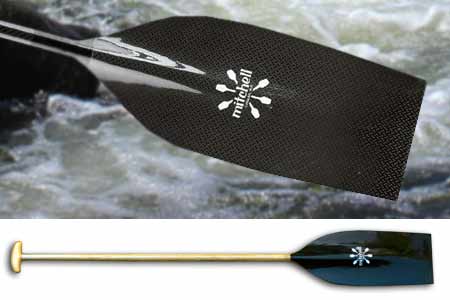Paddle Review: Mitchell Premier Whitewater Canoe Paddle
By Brian Johnston
I put my Mitchell Premier canoe paddle through its paces this spring. It stood up to the demand of 75 rapids during a 60-mile wilderness whitewater canoe trip. It preformed admirably on weekend river runs. It made me look good while instructing moving water canoe courses, both solo and tandem. Any paddle that is up to the challenge of diverse whitewater situations is truly a Premier paddle. The Mitchell proved itself to be a superior strong stick.
The Paddle. I have the wood shaft, carbon curved blade with a standard T-grip. The blade has a wooded core covered with carbon fiber, fiberglass rope edging, and an aluminum tip.
From Grip to Tip—Putting the Premier Paddle through its Paces
The standard grip is plain but comfortable. I was never wonting for anything in terms of the grip, be it bare handed or gloved. The grip was also used for grabbing boat grab loops as well as pulling on the opposite gunwale while rolling a canoe over to dump water. The standard T-grip worked fine.
The wooden shaft is warm, solid, and robust, but still rotates easily in my hand while using control strokes. If you like to choke on the shaft when executing a cross-bow draw, I found the transition unnoticeable because the shaft diameter gradually tapers. The shaft finish looks new even after not babying it during a paddling season.
The blade stands out while using combination strokes that involve in-water transitions because of the blade’s smooth in-water motion. The thin spline curve on the back face of the blade goes unnoticed during any paddle action—a plus for any paddle.
The blade’s fiberglass rope edging seamlessly blends into the blade. Not noticing this is a good thing. The blade feels and performs as a single identity.
Similarly, the blade’s inlaid aluminum tip performs without affecting the performance. As a paddler, I did not notice the aluminum tip while canoeing but upon inspection I found it had protected the blade tip from damage.
The paddle got scraped, banged rocks, and slid down rock slides. I used it to push off boulders, shield rock, and logs. The tough edges and tip held up well. The curved blade provides catch or purchase for a forward stoke, yet was still powerful when back paddling, and made it easy to identify the power face while instructing.
Off the water, I carried the paddle to scout rapids and bushwhack wilderness portage trails. In camp, it rained and the paddle became a lower corner tarp pole.
Other version and options include: wood shaft with a fiberglass sleeve, carbon fiber shaft, wood blade covered with fiberglass, or standard non-curved blade. Of all the possible versions, I like the wood shaft carbon curved blade. The only reason to get another version or a second paddle would be to get a lighter weight version, such as the carbon shaft carbon curved blade. For deck paddling (C1), a lightweight all-carbon version would aid a faster stroke rate.
Mitchell is well known for its paddles for good reason. The family run business makes outstanding paddles, offers excellent customer service, and has a satisfied customer base because of their repair reputation.
“The paddle got scraped, banged rocks, and slid down rock slides. I used it to push off boulders, shield rock, and logs. The tough edges and tip held up well. The curved blade provides catch or purchase for a forward stoke, yet was still powerful when back paddling, and made it easy to identify the power face while instructing…”
The Bottom Line
The Mitchell Premier is a tough and durable stick. You can’t go wrong with a Mitchell. It is an outstanding paddle worthy of being your primary paddle.
Contributor: Brian Johnston, Editor of the Paddle Canada Canoe Program. Brian has paddled Far North rivers of all kinds: swift descents from the mountains into the Mackenzie Valley, subarctic rivers emptying into the Arctic Ocean, traverses from the Northwest Territories to Nunavut, and drainages into Hudson Bay.











